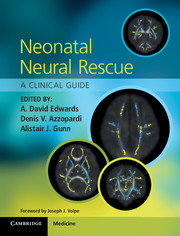Book contents
- Frontmatter
- Contents
- List of contributors
- Foreword
- Section 1 Scientific background
- Section 2 Clinical neural rescue
- 6 Challenges for parents and clinicians discussing neuroprotective treatments
- 7 The pharmacology of hypothermia
- 8 Selection of infants for hypothermic neural rescue
- 9 Hypothermia during patient transport
- 10 Whole body cooling for therapeutic hypothermia
- 11 Selective head cooling
- 12 Hypothermic neural rescue for neonatal encephalopathy in mid- and low-resource settings
- 13 Cerebral function monitoring and EEG
- 14 Magnetic resonance imaging in hypoxic–ischaemic encephalopathy and the effects of hypothermia
- 15 Novel uses of hypothermia
- 16 Neurological follow-up of infants treated with hypothermia
- 17 Registry surveillance after neuroprotective treatment
- Section 3 The future
- Index
- References
16 - Neurological follow-up of infants treated with hypothermia
from Section 2 - Clinical neural rescue
Published online by Cambridge University Press: 05 March 2013
- Frontmatter
- Contents
- List of contributors
- Foreword
- Section 1 Scientific background
- Section 2 Clinical neural rescue
- 6 Challenges for parents and clinicians discussing neuroprotective treatments
- 7 The pharmacology of hypothermia
- 8 Selection of infants for hypothermic neural rescue
- 9 Hypothermia during patient transport
- 10 Whole body cooling for therapeutic hypothermia
- 11 Selective head cooling
- 12 Hypothermic neural rescue for neonatal encephalopathy in mid- and low-resource settings
- 13 Cerebral function monitoring and EEG
- 14 Magnetic resonance imaging in hypoxic–ischaemic encephalopathy and the effects of hypothermia
- 15 Novel uses of hypothermia
- 16 Neurological follow-up of infants treated with hypothermia
- 17 Registry surveillance after neuroprotective treatment
- Section 3 The future
- Index
- References
Summary
Introduction
The theory, timelines, measures and services for the follow-up care of high-risk infants have been well described [1–3]. Amiel-Tison’s overview of the trajectory of child development after birth asphyxia in the term infant continues to give guidelines for the sequential diagnosis of abnormalities [4]. Although neural protection has been shown to lessen major disabilities among survivors [5], there is no indication that the approach to long-term follow-up should be altered. This chapter focuses on the neurological examination as a tool to assist and augment the neurodevelopmental and neurocognitive follow-up of neonates after hypothermia. Examples of assessment and rating tools are given. Many other measures would also be appropriate. Measures should be standardized for the population where the test is given and be the latest edition available. Where possible a comparison population should also be tested. Within each section, there is a discussion on early referral for intervention services to reduce adverse outcomes. The organization of this chapter is patterned after the timelines approach of Amiel-Tison [4] with less emphasis on individual disabilities than in other publications on outcome of term infants with perinatal asphyxia [6,7].
Defining the cohort
The focus of this book is on techniques to preserve neurological function in neonates compromised by perinatal asphyxia. By extension, follow-up should not only document outcomes but provide services to reduce the impact of the insult on limitations of function, activities and participation for each child [8]. Clarity of definition of diagnosis not only of the initial insult but of associated diagnoses will assist both outcomes research and service to the child and family [6]. For more than three decades the words hypoxic–ischaemic encephalopathy (HIE) in the term newborn suggested neonatal encephalopathy beginning within hours of intrapartum asphyxia where there was evidence of fetal distress (fetal heart rate abnormalities, meconium-stained amniotic fluid and depression at birth [4,6]. This definition did not preclude an earlier antepartum acute or chronic hypoxic event. However, reports generally excluded children with known chromosomal abnormalities, syndromes or malformations of the central nervous system and those with intracranial haemorrhage. In general, there has been little mention of excluding children from outcome studies after HIE who also had antenatal infections such as cytomegalovirus, or exposure to toxins such as maternally consumed illicit drugs. Such exclusions should be considered in the future.
- Type
- Chapter
- Information
- Neonatal Neural RescueA Clinical Guide, pp. 172 - 181Publisher: Cambridge University PressPrint publication year: 2013



